
Wine Culture and Information since 2002 - Volume 22
 Wine Culture and Information since 2002 - Volume 22 |
|
Contrasts of Curtefranca Rosso and Chianti ClassicoTwo red wines, among the most representative ones in their respective regions, Lombardy and Tuscany, are compared in the glasses of the tasting by contrast of this month |
|
When it comes to Tuscan wines, Chianti Classico is, undeniably, one of the first everyone thinks of, a wine that has marked the enological history of this region and, in many respects, also that of Italy. Lombardy stands out for its different styles of wine and, among them, reds play an important role. When it comes to Lombardy, of course, the most recognizable denomination is Franciacorta, undeniably among the most celebrated sparkling wines of Italy. Franciacorta, however, is not only made of bubbles as in this area white and red wines belonging to the Curtefranca denomination are also produced. The history of Franciacorta's still wines is certainly more recent than those of Chianti, however in this part of Lombardy there are mentions about mordaci wines – an ancient term to refer to effervescent and sparkling styles – as early as the sixteenth century. The wines of the tasting by contrast of this month are evidently different and distant, not only in geographical terms. In Chianti Classico, in fact, it is the Sangiovese grape to dominate the scene, while in Curtefranca Rosso it is the international grapes responsible to the character making up the wines of this territory. Of course, they are wines belonging to different enological histories, strongly linked to their respective territories and according to the viticultural and enological developments which have occurred over time. In both cases, it must be said, there have been adaptations and modifications such as to make these wines very different today when compared to the past. This is occurred, in particular, for Chianti Classico which has recently seen the introduction in its composition of international varieties, as a matter of fact, grapes allowed for cultivation in Tuscany.
|
|
The territory of the Denominazione d'Origine Controllata Curtefranca (Denomination of Controlled Origin) provides for the production of white and red wines and it exactly corresponds to that of Franciacorta, the famous area in which sparkling wines are produced with the homonymous method. At the beginning of its definition – in fact – the denomination Franciacorta provided, in addition to the production of sparkling wines, also that of still table wines. The birth of this important denomination dates back to 1967 and it was then divided into two distinct denominations in 1995: one exclusively reserved for sparkling wine production – and which retains the name “Franciacorta” – the other one for still table wines and which will take the name “Terre di Franciacorta ”. In order to avoid confusion with the name reserved for sparkling wines, the latter denomination changed again its name in 2008 to the current “Curtefranca”. The denomination provides, as in its initial definition, the production of both white and red wines and corresponds to the same territory of Franciacorta. Curtefranca Rosso is mainly produced – according to its production disciplinary – with the so called “international” varieties, to which can also be added “Italian” grapes and historically found in this territory. The red is made up of Cabernet Franc and Carmenère – alone or together – for a minimum of 20%, Merlot for a minimum of 25% and Cabernet Sauvignon for a minimum of 10% and a maximum of 35%. Non-aromatic varieties can also be used in the production of Curtefranca Rosso, in such a case they must be allowed for the cultivation in Lombardy, for a maximum of 15%. This remaining part is generally represented – when used – by Barbera and Nebbiolo. The denomination Curtefranca Rosso also provides for the mention of the vineyard of origin of the grapes and, in this specific case, it is required a minimum aging of 8 months in wood. In this regard, it should be noted that aging in wood – cask or barrique – is also frequent for Curtefranca Rosso without the mention of the vineyard, however, in some cases, are also used inert containers, such as stainless steel tanks.
|
||||
|
Chianti Classico is, undoubtedly, one of the Italian wines having a long history and solid prestige, in addition to international fame. Valuable ambassador of Tuscan and Italian enology in the world, Chianti is also one of the first wines of our country for which both the viticultural practices and the production area have been defined. The definition of the production areas of Chianti, Carmignano, Pomino and Valdarno di Sopra was in fact owed to Grand Duke Cosimo III de 'Medici with the issue of a special edict. It was September 24th, 1716 and the provision of Grand Duke Cosimo III can be considered – as a matter of fact – the first wine production disciplinary issued in Italy. This episode also gives us a clear idea of the cultural and commercial importance of the wines to which this edict refers – including Chianti – and for which was needed the regulation of their production with the aim of protecting their identity and preventing fraud. The territory of Chianti Classico is notoriously found between today's provinces of Florence and Siena, in an area of 70,000 hectares and includes the municipalities of Castellina in Chianti, Gaiole in Chianti, Greve in Chianti, Radda in Chianti and partly those of Barberino Tavarnelle, Castelnuovo Berardenga, Poggibonsi and San Casciano in Val di Pesa. Throughout its history, Chianti Classico has undergone several changes in production, up to reaching 1874 when Baron Bettino Ricasoli defines the grape varieties and his famous recipe: Sangiovese in large part, Canaiolo Nero, Malvasia Bianca and Trebbiano Toscano. This famous formula will remain unchanged until 1984, when the production disciplinary is revised, up to the last modification which provides for a minimum quantity of Sangiovese of 80% and the remaining part consisting of red berried varieties permitted for cultivation in Tuscany. Chianti Classico is recognized by the Italian quality system as a Denominazione d'Origine Controllata e Garantita territory (DOCG, Controlled and Guaranteed Denomination of Origin).
|
Let's start the tasting by contrast of this month and choose the wines we will pour into our glasses. The production of the two wines we are going to examine this month involves – in both cases and according to the respective disciplinary – the use of different grapes. For this reason, we need to pay attention to their composition, making sure they are produced with the grapes listed below. As for Curtefranca Rosso, we will choose a wine produced with Cabernet Franc, Carmenère, Merlot and Cabernet Sauvignon, possibly with the first two grapes in a dominant quantity. In choosing Chianti Classico we will make sure the wine is mainly produced with Sangiovese – and this is required by its disciplinary – with the addition of Canaiolo Nero. As far as the aging technique is concerned, in both cases we will choose wines aged in cask for at least 8 months. The two wines are poured into their respective tasting glasses at a temperature of 18 °C. (65 °F) The first sensorial quality we will examine in the wines of our tasting is, as usual, the appearance, that is, the evaluation of color and transparency. The first wine of which we will evaluate this sensorial quality is Curtefranca Rosso, by placing the glass tilted over a white surface, such as a napkin or a sheet of paper. Let's observe the base of the glass: we notice an intense ruby red color and moderate transparency which makes quite difficult seeing the object put in contrast. The nuance of Curtefranca Rosso, observed at the edge of the wine, towards the opening of the glass, confirms the ruby red color. Let's now pass to the observation of Chianti Classico and, as for the previous wine, we tilt the glass over the white surface. The Tuscan wine presents itself to our eyes with a bright and intense ruby red color, moderate transparency, generally superior to Curtefranca Rosso. The nuance of Chianti Classico confirms the brilliant ruby red color. The differences between Curtefranca Rosso and Chianti Classico become evident – undoubtedly – in the evaluation of the respective olfactory profiles. These two wines, in fact, are produced with different grapes and, as such, characterized by distant sensorial qualities. Curtefranca Rosso is generally produced with Cabernet Franc, Carmenère, Merlot, Caberbet Sauvignon, often Nebbiolo and Barbera; Chianti Classico is mainly composed of Sangiovese, a variety representing at least 80% of the total. In both wines the expression of black pulp fruits is dominant, although with different qualities. In Curtefranca Rosso, black currant, black cherry, plum and blueberry dominate, while in Chianti Classico the nose is characterized by black cherry, plum, blueberry and blackberry. In the Tuscan wine can also be perceived sensations of red pulp fruits, in particular raspberry. In both wines the world of flowers is dominated by violet, while in the Chianti Classico the scent of the rose is sometimes perceived. Let's proceed with the tasting and examine the olfactory profile of Curtefranca Rosso. By keeping the glass in vertical position and, without swirling, we do the first smell in order to appreciate the opening of the wine, that is, the primary sensations that are perceived to the nose. Curtefranca Rosso gives the nose intense and clean aromas of black currant, plum and black cherry to which is added the pleasant scent of violet. After having swirled the glass, an operation notoriously favoring the development of the other aromas, we do a new smell. The profile of Lombard wine is completed with blueberry and, sometimes, vegetable sensations reminiscent of green bell pepper, as well as typical qualities of the aging in wood, such as vanilla and chocolate, often a balsamic hint reminiscent of menthol. The opening of Chianti Classico is very different, evaluated by keeping the glass in vertical and without swirling, it is characterized by black cherry, plum and raspberry, also in this case combined with the elegant scent of violet. After having swirled the glass, the olfactory profile of Chianti Classico is completed with blueberry, blackberry, rose and cyclamen, in addition to the typical tertiary sensations given by the aging in wood. After the evaluation of the olfactory sensations of the two wines, we proceed with the examination of the gustatory profiles, starting, just like the previous phases, from Curtefranca Rosso. The first quality we will evaluate, as usual, is the attack of the wine, that is the primary sensations perceived in the mouth. Let's take a sip of the Lombard wine: the attack is characterized by a good sensation of astringency produced by tannins to which is opposed – and contributing to balance – the effect of alcohol and roundness. In the mouth are perceived flavors of black currant, plum and black cherry with a good correspondence to the nose, that is with the sensations perceived in the opening of the olfactory analysis. Let's move on to the evaluation of the attack of Chianti Classico and take a sip of the Tuscan wine. In the mouth is perceived the good astringency of tannins – however lower than that of Curtefranca Rosso – in addition to the pleasing crispness given by acidity, a characteristic frequently perceptible in wines produced with Sangiovese. The correspondence to the nose is also very good in this wine: the flavors of black cherry, plum and raspberry are clearly perceptible in the mouth. Our tasting by contrast ends with the evaluation of the final sensations the wines leave in the mouth after swallowing, in particular, the taste-olfactory persistence, among the most important factors determining quality. The finish of Curtefranca Rosso is characterized by a good persistence, in which both the sensation of structure and astringency are still perceived besides the flavors of black currant, plum and black cherry. The sensations of crispness and roundness are moderate, mainly due to the grapes used for the production. The finish of Chianti Classico is characterized by a good persistence and in the mouth is still well perceptible the sensation of crispness given by the typical acidity of Sangiovese, while being balanced by the pleasing roundness and the effect of alcohol. Moreover, in the mouth can be still perceived, clean and intense, the flavors of black cherry, plum and raspberry. Before concluding our tasting, let's focus again on the comparison of the olfactory and gustatory qualities of the two wines: the sensorial differences are evident and distant.
|
||||||||
Wines of the Month |
|
|
|
Score legend Prices are to be considered as indicative. Prices may vary according to the country or the shop where wines are bought |
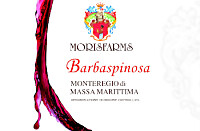
|
|
Maremma Toscana Rosso Barbaspinosa 2015 |
|
| Moris Farms (Tuscany, Italy) | |
 Sangiovese (90%), Cabernet Sauvignon (10%) Sangiovese (90%), Cabernet Sauvignon (10%) | |
| Price: € 12.90 | Score: |
 Intense ruby red and nuances of ruby red, little transparency. Intense ruby red and nuances of ruby red, little transparency. Intense, clean, pleasing and refined, starts with hints of black
cherry, plum and black currant followed by aromas of violet, blueberry,
carnation, blackberry, chocolate, tobacco, vanilla and menthol. Intense, clean, pleasing and refined, starts with hints of black
cherry, plum and black currant followed by aromas of violet, blueberry,
carnation, blackberry, chocolate, tobacco, vanilla and menthol.
 Properly tannic attack and however balanced by alcohol, good body,
intense flavors, agreeable. Properly tannic attack and however balanced by alcohol, good body,
intense flavors, agreeable.
 Persistent finish with flavors of black cherry, plum and black currant. Persistent finish with flavors of black cherry, plum and black currant. 12 months in barrique. 12 months in barrique. |
|
 Broiled meat and barbecue, Roasted meat, Stewed and braised meat with mushrooms, Hard cheese Broiled meat and barbecue, Roasted meat, Stewed and braised meat with mushrooms, Hard cheese |
|
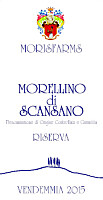
|
|
Morellino di Scansano Riserva 2016 |
|
| Moris Farms (Tuscany, Italy) | |
 Sangiovese (90%), Cabernet Sauvignon, Merlot (10%) Sangiovese (90%), Cabernet Sauvignon, Merlot (10%) | |
| Price: € 18.60 | Score: |
 Intense ruby red and nuances of ruby red, little transparency. Intense ruby red and nuances of ruby red, little transparency. Intense, clean, pleasing and refined, starts with hints of black
cherry, plum and blueberry followed by aromas of violet, peony, chocolate,
pink pepper, cinnamon, tobacco, vanilla and menthol. Intense, clean, pleasing and refined, starts with hints of black
cherry, plum and blueberry followed by aromas of violet, peony, chocolate,
pink pepper, cinnamon, tobacco, vanilla and menthol.
 Properly tannic attack and however balanced by alcohol, good body,
intense flavors, agreeable. Properly tannic attack and however balanced by alcohol, good body,
intense flavors, agreeable.
 Persistent finish with flavors of black cherry, plum and blueberry. Persistent finish with flavors of black cherry, plum and blueberry. 12 months in barrique, 6 months in bottle. 12 months in barrique, 6 months in bottle. |
|
 Broiled meat and barbecue, Roasted meat, Stewed and braised meat with mushrooms, Hard cheese Broiled meat and barbecue, Roasted meat, Stewed and braised meat with mushrooms, Hard cheese |
|
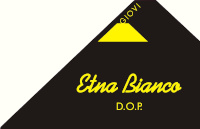
|
|
Etna Bianco 2018 |
|
| Giovi (Sicily, Italy) | |
 Carricante (85%), Grecanico (15%) Carricante (85%), Grecanico (15%) | |
| Price: € 14.00 | Score: |
 Brilliant golden yellow and nuances of golden yellow, very transparent. Brilliant golden yellow and nuances of golden yellow, very transparent. Intense, clean, pleasing and refined, starts with hints of plum, apple
and hawthorn followed by aromas of grapefruit, citrus fruit peel, medlar,
hazelnut, almond, honey and hints of vanilla. Intense, clean, pleasing and refined, starts with hints of plum, apple
and hawthorn followed by aromas of grapefruit, citrus fruit peel, medlar,
hazelnut, almond, honey and hints of vanilla.
 Crisp attack and however balanced by alcohol, good body, intense
flavors, pleasing roundness. Crisp attack and however balanced by alcohol, good body, intense
flavors, pleasing roundness.
 Persistent finish with flavors of apple, plum and grapefruit. Persistent finish with flavors of apple, plum and grapefruit. 3 months in cask. 3 months in cask. |
|
 Stuffed pasta, Roasted fish, Broiled fish, ,Roasted white meat Stuffed pasta, Roasted fish, Broiled fish, ,Roasted white meat |
|
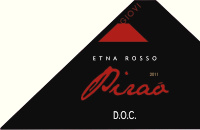
|
|
Etna Rosso Pirao 2011 |
|
| Giovi (Sicily, Italy) | |
 Nerello Mascalese Nerello Mascalese | |
| Price: € 30.00 | Score: |
 Brilliant ruby red and nuances of garnet red, moderate transparency. Brilliant ruby red and nuances of garnet red, moderate transparency. Intense, clean, pleasing, refined and elegant, starts with hints of
cherry, raspberry and dried violet followed by aromas of blueberry, dried
rose, strawberry, licorice, cocoa, tobacco, carob, tar, mace, vanilla and
menthol. Intense, clean, pleasing, refined and elegant, starts with hints of
cherry, raspberry and dried violet followed by aromas of blueberry, dried
rose, strawberry, licorice, cocoa, tobacco, carob, tar, mace, vanilla and
menthol.
 Properly tannic attack and however balanced by alcohol, good body,
intense flavors, pleasing crispness. Properly tannic attack and however balanced by alcohol, good body,
intense flavors, pleasing crispness.
 Persistent finish with flavors of cherry, raspberry and strawberry. Persistent finish with flavors of cherry, raspberry and strawberry. 12 months in cask. 12 months in cask. |
|
 Roasted meat, Stewed meat with mushrooms, Broiled meat and barbecue, Cheese Roasted meat, Stewed meat with mushrooms, Broiled meat and barbecue, Cheese |
|
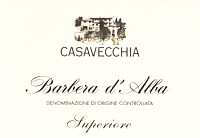
|
|
Barbera d'Alba Superiore 2015 |
|
| Casavecchia (Piedmont, Italy) | |
 Barbera Barbera | |
| Price: € 8.50 | Score: |
 Intense ruby red and nuances of ruby red, little transparency. Intense ruby red and nuances of ruby red, little transparency. Intense, clean, pleasing and refines, starts with hints of cherry, plum
and blueberry followed by aromas of violet, raspberry, blackberry,
chocolate, tobacco, mace, vanilla and menthol. Intense, clean, pleasing and refines, starts with hints of cherry, plum
and blueberry followed by aromas of violet, raspberry, blackberry,
chocolate, tobacco, mace, vanilla and menthol.
 Properly tannic attack and however balanced by alcohol, good body,
intense flavors, pleasing crispness. Properly tannic attack and however balanced by alcohol, good body,
intense flavors, pleasing crispness.
 Persistent finish with flavors of cherry, plum and blueberry. Persistent finish with flavors of cherry, plum and blueberry. 12 months in cask, at least 6 months in bottle. 12 months in cask, at least 6 months in bottle. |
|
 Broiled meat and barbecue, Roasted meat, Stewed meat with mushrooms Broiled meat and barbecue, Roasted meat, Stewed meat with mushrooms |
|
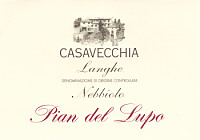
|
|
Langhe Nebbiolo Pian del Lupo 2013 |
|
| Casavecchia (Piedmont, Italy) | |
 Nebbiolo (85%), Merlot (15%) Nebbiolo (85%), Merlot (15%) | |
| Price: € 13.00 | Score: |
 Brilliant ruby red and nuances of garnet red, moderate transparency. Brilliant ruby red and nuances of garnet red, moderate transparency. Intense, clean, pleasing, refined and elegant, starts with hints of
cherry, plum and raspberry followed by aromas of violet, blueberry,
strawberry, rose, chocolate, cinnamon, tobacco, mace, vanilla and menthol. Intense, clean, pleasing, refined and elegant, starts with hints of
cherry, plum and raspberry followed by aromas of violet, blueberry,
strawberry, rose, chocolate, cinnamon, tobacco, mace, vanilla and menthol.
 Properly tannic attack and however balanced by alcohol, good body,
intense flavors, pleasing crispness. Properly tannic attack and however balanced by alcohol, good body,
intense flavors, pleasing crispness.
 Persistent finish with flavors of cherry, plum and blueberry. Persistent finish with flavors of cherry, plum and blueberry. 18 months in barrique, 12 months in bottle. 18 months in barrique, 12 months in bottle. |
|
 Roasted meat, Broiled meat and barbecue, Stewed and braised meat with mushrooms, Hard cheese Roasted meat, Broiled meat and barbecue, Stewed and braised meat with mushrooms, Hard cheese |
|
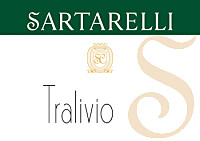
|
|
Verdicchio dei Castelli di Jesi Classico Superiore Tralivio 2017 |
|
| Sartarelli (Marches, Italy) | |
 Verdicchio Verdicchio | |
| Price: € 17.00 | Score: |
 Brilliant straw yellow and nuances of straw yellow, very transparent. Brilliant straw yellow and nuances of straw yellow, very transparent. Intense, clean, pleasing, refined and elegant, starts with hints of
apple, plum and citrus fruits followed by aromas of pear, almond, medlar,
hawthorn, broom, linden, rosemary and mineral. Intense, clean, pleasing, refined and elegant, starts with hints of
apple, plum and citrus fruits followed by aromas of pear, almond, medlar,
hawthorn, broom, linden, rosemary and mineral.
 Crisp attack and however balanced by alcohol, good body, intense
flavors, agreeable. Crisp attack and however balanced by alcohol, good body, intense
flavors, agreeable.
 Persistent finish with flavors of apple, plum and almond. Persistent finish with flavors of apple, plum and almond. Aged in steel tanks. Aged in steel tanks. |
|
 Broiled fish, Roasted white meat, Fish soups and mushrooms, Stuffed pasta Broiled fish, Roasted white meat, Fish soups and mushrooms, Stuffed pasta |
|
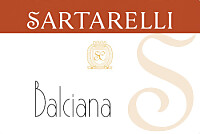
|
|
Verdicchio dei Castelli di Jesi Classico Superiore Balciana 2016 |
|
| Sartarelli (Marches, Italy) | |
 Verdicchio Verdicchio | |
| Price: € 38.00 | Score: |
 Intense golden yellow and nuances of golden yellow, very transparent. Intense golden yellow and nuances of golden yellow, very transparent. Intense, clean, pleasing, refined and elegant, starts with hints of
quince, medlar and apricot followed by aromas of honey, saffron, plum,
pear, noble rot, pineapple, chamomile, beeswax, mango, hawthorn, almond,
linden and mineral. Intense, clean, pleasing, refined and elegant, starts with hints of
quince, medlar and apricot followed by aromas of honey, saffron, plum,
pear, noble rot, pineapple, chamomile, beeswax, mango, hawthorn, almond,
linden and mineral.
 Crisp attack and however balanced by alcohol, full body, intense
flavors, pleasing roundness. Crisp attack and however balanced by alcohol, full body, intense
flavors, pleasing roundness.
 Very persistent finish with long flavors of quince, apricot and honey. Very persistent finish with long flavors of quince, apricot and honey. Aged in steel tanks. Aged in steel tanks. |
|
 Stuffed pasta with mushrooms, Roasted fish, Roasted white meat, Cheese Stuffed pasta with mushrooms, Roasted fish, Roasted white meat, Cheese |
|
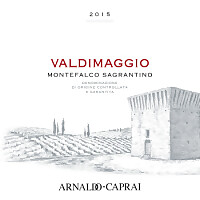
|
|
Montefalco Sagrantino Valdimaggio 2015 |
|
| Arnaldo Caprai (Umbria, Italy) | |
 Sagrantino Sagrantino | |
| Price: € 32.00 | Score: |
 Intense ruby red and nuances of ruby red, little transparency. Intense ruby red and nuances of ruby red, little transparency. Intense, clean, pleasing, refined and elegant, starts with hints of
blackberry, black cherry and plum followed by aromas of violet, blueberry,
iris, chocolate, tobacco, cinnamon, pink pepper, leather, mace, vanilla and
menthol. Intense, clean, pleasing, refined and elegant, starts with hints of
blackberry, black cherry and plum followed by aromas of violet, blueberry,
iris, chocolate, tobacco, cinnamon, pink pepper, leather, mace, vanilla and
menthol.
 Tannic attack and however balanced by alcohol, full body, intense
flavors, agreeable. Tannic attack and however balanced by alcohol, full body, intense
flavors, agreeable.
 Very persistent with long flavors of blackberry, black cherry and plum. Very persistent with long flavors of blackberry, black cherry and plum. 24 months in barrique, at least 8 months in bottle. 24 months in barrique, at least 8 months in bottle. |
|
 Game, Stewed and braised meat, Roasted meat, Hard cheese Game, Stewed and braised meat, Roasted meat, Hard cheese |
|
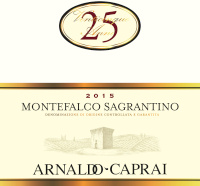
|
|
Montefalco Sagrantino 25 Anni 2015 |
|
| Arnaldo Caprai (Umbria, Italy) | |
 Sagrantino Sagrantino | |
| Price: € 50.00 | Score: |
 Deep ruby red and nuances of ruby red, little transparency. Deep ruby red and nuances of ruby red, little transparency. Intense, clean, pleasing, refined and elegant, starts with hints of
blackberry, black cherry and plum followed by aromas of violet, blueberry,
peony, face powder, chocolate, tobacco, clove, pink pepper, mace, leather,
vanilla and menthol. Intense, clean, pleasing, refined and elegant, starts with hints of
blackberry, black cherry and plum followed by aromas of violet, blueberry,
peony, face powder, chocolate, tobacco, clove, pink pepper, mace, leather,
vanilla and menthol.
 Tannic attack and however balanced by alcohol, full body, intense
flavors, agreeable. Tannic attack and however balanced by alcohol, full body, intense
flavors, agreeable.
 Very persistent finish with long flavors of blackberry, black cherry
and plum. Very persistent finish with long flavors of blackberry, black cherry
and plum.
 24 months in barrique, at least 8 months in bottle. 24 months in barrique, at least 8 months in bottle. |
|
 Game, Roasted meat, Stewed and braised meat, Hard cheese Game, Roasted meat, Stewed and braised meat, Hard cheese |
|
|
||||||||
|
DiWineTaste Polls
|
| |||||||
Privacy Policy | |||||||


| Copyright © 2002-2024 Antonello Biancalana, DiWineTaste - All rights reserved |
| All rights reserved under international copyright conventions. No part of this publication and of this WEB site may be
reproduced or utilized in any form or by any means, electronic or mechanical, without permission in writing from DiWineTaste. |